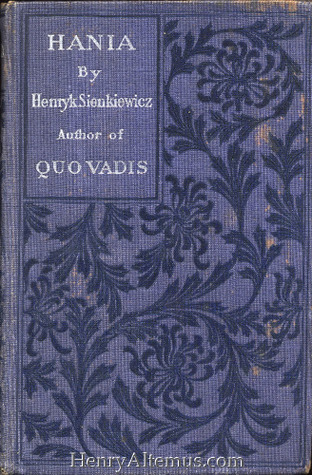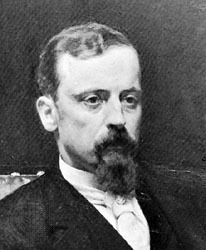
When old Mikolai on his death-bed left Hania to my guardianship and conscience, I was sixteen years of age; she was younger by almost a year, and was also just emerging from childhood. I had to lead her from the bed of her dead grandfather almost by force, and we both went to my father's domestic chapel. The doors of the chapel were open, and before the old Byzantine image of the Mother of God two candles were burning. The gleam of these lighted but faintly the darkness on the altar. We knelt down, one at the side of the other. She, broken by sorrow, wearied by sobbing, sleeplessness, and grief, rested her poor little head on my arm, and so we remained there in silence. The hour was late; in the hall adjoining the chapel, the cuckoo called hoarsely on the old Dantiz clock the second hour after midnight. Deep silence everywhere, broken only by the painful sighs of Hania, and by the distant sound of the snow-bearing wind, which at times shook the leaden window-sash in the chapel. I did not dare to speak one word of solace; I merely drew her toward me, as her guardian, or her elder brother... That's the start to Henryk Sienkiewicz's powerful "Hania" — which is nearly long enough to qualify as a novel, but is probably more rightly described as a novella. Regardless, this collection contains much, much more than "Hania" — it includes "Tartar Captivity," "Let Us Follow Him," "Be Thou Blessed," "At the Source," "Charcoal Sketches," "The Organist of Ponikla," "Lux in Tenebris Lucet," "On the Bright Shore," and "That Third Woman." When old Mikolai on his death-bed left Hania to my guardianship and conscience, I was sixteen years of age; she was younger by almost a year, and was also just emerging from childhood. I had to lead her from the bed of her dead grandfather almost by force, and we both went to my father's domestic chapel. The doors of the chapel were open, and before the old Byzantine image of the Mother of God two candles were burning. The gleam of these lighted but faintly the darkness on the altar. We knelt down, one at the side of the other. She, broken by sorrow, wearied by sobbing, sleeplessness, and grief, rested her poor little head on my arm, and so we remained there in silence. The hour was late; in the hall adjoining the chapel, the cuckoo called hoarsely on the old Dantiz clock the second hour after midnight. Deep silence everywhere, broken only by the painful sighs of Hania, and by the distant sound of the snow-bearing wind, which at times shook the leaden window-sash in the chapel. I did not dare to speak one word of solace; I merely drew her toward me, as her guardian, or her elder brother... That's the start to Henryk Sienkiewicz's powerful "Hania" — which is nearly long enough to qualify as a novel, but is probably more rightly described as a novella. Regardless, this collection contains much, much more than "Hania" — it includes "Tartar Captivity," "Let Us Follow Him," "Be Thou Blessed," "At the Source," "Charcoal Sketches," "The Organist of Ponikla," "Lux in Tenebris Lucet," "On the Bright Shore," and "That Third Woman."
Author

Henryk Adam Aleksander Pius Sienkiewicz (also known as "Litwos"; May 5, 1846–November 15, 1916) was a Polish journalist and Nobel Prize-winning novelist. He was one of the most popular Polish writers at the turn of the 19th and 20th centuries, and received the Nobel Prize in Literature in 1905 for his "outstanding merits as an epic writer." Born into an impoverished gentry family in the Podlasie village of Wola Okrzejska, in Russian-ruled Poland, Sienkiewicz wrote historical novels set during the Rzeczpospolita (Polish Republic, or Commonwealth). His works were noted for their negative portrayal of the Teutonic Order in The Teutonic Knights (Krzyżacy), which was remarkable as a significant portion of his readership lived under German rule. Many of his novels were first serialized in newspapers, and even today are still in print. In Poland, he is best known for his historical novels "With Fire and Sword", "The Deluge", and "Fire in the Steppe" (The Trilogy) set during the 17th-century Polish-Lithuanian Commonwealth, while internationally he is best known for Quo Vadis, set in Nero's Rome. Quo Vadis has been filmed several times, most notably the 1951 version. Sienkiewicz was meticulous in attempting to recreate the authenticity of historical language. In his Trilogy, for instance, he had his characters use the Polish language as he imagined it was spoken in the seventeenth century (in reality it was far more similar to 19th-century Polish than he imagined). In The Teutonic Knights, which relates to the Battle of Grunwald in 1410, he even had his characters speak a variety of medieval Polish which he recreated in part from archaic expressions then still common among the highlanders of Podhale. In 1881, Sienkiewicz married Maria Szetkiewicz (1854-1885). They had two children, Henryk Józef (1882-1959) and Jadwiga Maria (1883–1969).